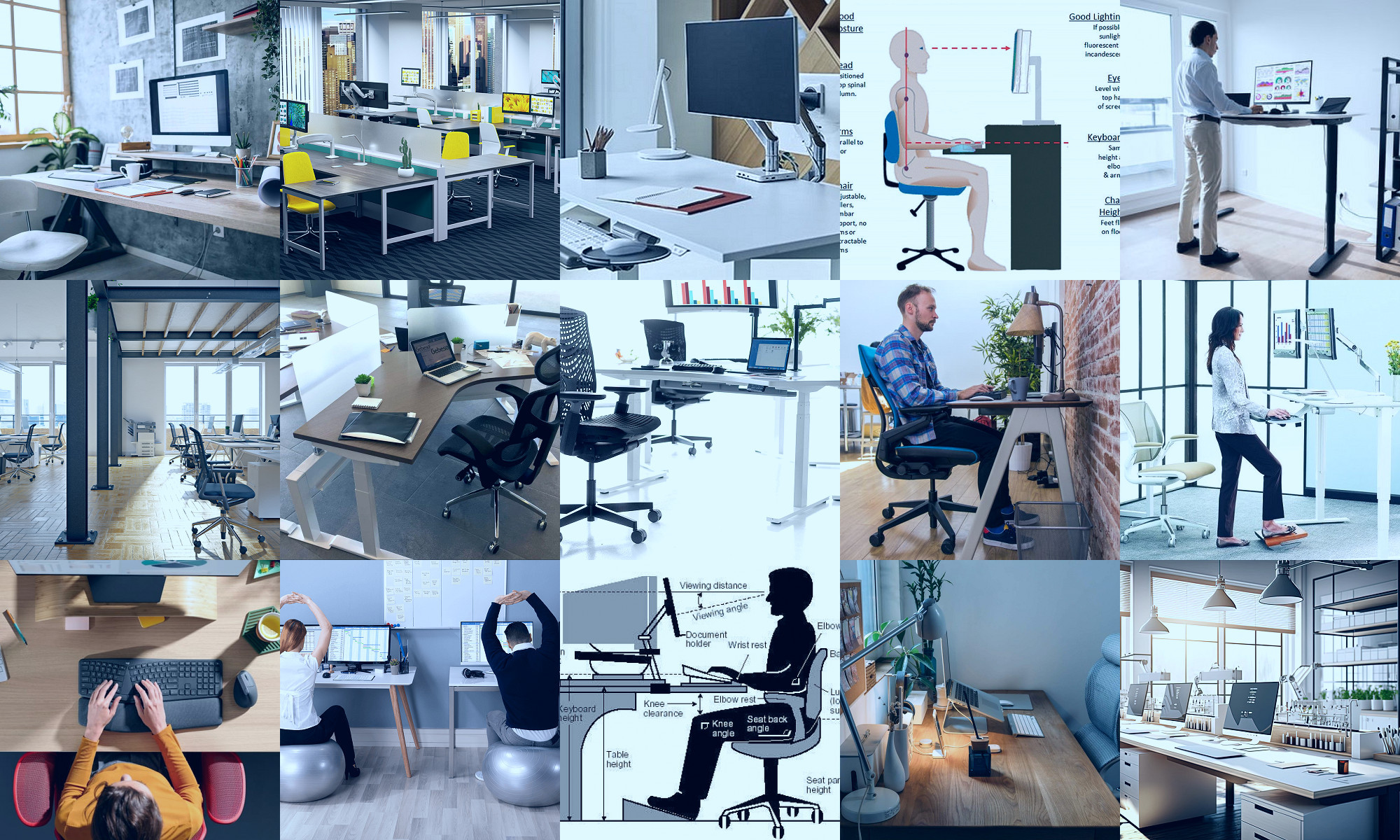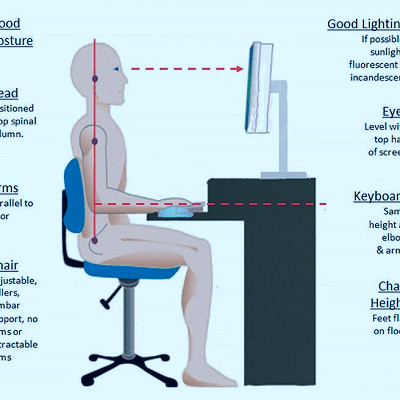 Jarlat Maletych/Shutterstock
Jarlat Maletych/Shutterstock
Features
Understanding Ergonomics
Ergonomics is a scientific discipline that studies the interaction between humans and other elements of a system. It aims to optimize human wellbeing and overall system performance by making products and tasks comfortable and efficient.
Importance of Ergonomically Designed Workspaces
An ergonomically designed workspace improves productivity, enhances comfort, and reduces the risk of work-related injuries. It involves arranging workstations, equipment, and procedures to fit the worker’s capabilities and limitations.
Role of Proper Seating
An ergonomically designed chair supports the natural curvature of the spine, reduces strain on the back muscles, and prevents long-term spinal problems. It should have an adjustable height, backrest, armrests, and sufficient seat depth and width.
Importance of Adequate Desk Height
The right desk height can prevent musculoskeletal problems associated with prolonged sitting. An ideal desk should allow the worker's elbows to be at a 90-degree angle when typing, and feet flat on the floor or a footrest.
Value of Adjustable Monitors
Monitors should be adjustable to avoid neck and eye strain. The top of the screen should be at or slightly below eye level, and the screen should be approximately an arm's length away.
Significance of Proper Lighting
Good lighting minimizes eye strain and headaches. It should be bright enough to read documents easily but not so bright that it causes glare or contrasts sharply with the surrounding environment.
Role of Keyboard and Mouse Positioning
The keyboard and mouse should be placed close to each other to prevent overreaching, which can cause shoulder and arm strain. They should also be at the same height as the elbows when seated.
Benefits of Standing Desks
Standing desks can reduce the risks associated with prolonged sitting, such as obesity, heart disease, and musculoskeletal disorders. They improve posture, increase energy levels, and boost productivity.
Importance of Regular Breaks
Regular breaks are essential in maintaining physical and mental health. They reduce fatigue, stress, and the risk of developing musculoskeletal disorders.
Incorporating Physical Activity
Incorporating physical activity into the workday can reduce the risk of chronic diseases, improve mental health, and boost productivity. This could include walking meetings, stretching exercises, or using a fitness ball as a chair.
Use of Ergonomic Tools
Ergonomic tools, such as document holders, footrests, and adjustable armrests, can help reduce the risk of work-related injuries.
Investing in Ergonomic Training
Providing ergonomic training to employees helps them understand the importance of ergonomics and how to implement changes in their workstations to improve comfort and efficiency.
Role of Natural Elements
Incorporating natural elements, like plants and natural light, can improve air quality, reduce stress, and increase productivity.
Importance of Noise Control
Controlling noise levels can reduce distractions, improve concentration, and decrease stress levels.
Healthy Work Habits
Developing healthy work habits, like good posture, regular exercise, and proper nutrition, can improve overall health and productivity.
Role of Telework
Telework allows employees to customize their work environment to their ergonomic needs, reducing the risk of musculoskeletal disorders.
Importance of Regular Workstation Assessments
Regular workstation assessments can identify potential ergonomic risks and provide solutions to improve comfort and efficiency.
Role of Occupational Therapists
Occupational therapists can provide expert guidance on creating ergonomically sound workspaces that promote health and productivity.
Benefits of Ergonomic Consultation
Ergonomic consultation can help identify specific needs and provide customized solutions to improve the comfort and efficiency of workspaces.
Future of Ergonomics
With advancements in technology, the future of ergonomics holds promise for more personalized and efficient workspaces, incorporating elements like virtual reality, artificial intelligence, and advanced biometrics.
Interesting notes and facts
1. The Science of Ergonomics: Ergonomics is the science of designing and arranging things people use so that the people and things interact most efficiently and safely. It involves designing products, processes, or systems to take proper account of human interaction. In simpler terms, ergonomics makes your work environment adapt to you, rather than forcing you to adapt to it.2. Prevention of Musculoskeletal Disorders: Did you know that working in an ergonomically designed workspace can prevent musculoskeletal disorders? These disorders often develop over time and can lead to conditions like carpal tunnel syndrome, tendonitis, and other debilitating conditions. By designing your workspace to fit you, you can reduce the risk of these disorders.
3. Ergonomics Boosts Productivity: Studies have consistently shown that a well-designed, ergonomic workspace can significantly increase productivity. This is because an ergonomically friendly work environment reduces physical stress and fatigue, allowing you to work more efficiently and for longer periods.
4. The Role of Furniture: Ergonomic furniture plays a crucial role in creating an efficient workspace. From adjustable chairs that support your back to desks at the right height for comfortable typing, every piece of furniture matters. These adjustments can help reduce the strain on your body and improve your overall health and well-being.
5. Importance of Breaks: Ergonomic workspaces aren't just about furniture and layout. Taking regular short breaks to move around is an essential part of maintaining an ergonomic working environment. It helps to prevent strain and fatigue, keeping you energized and focused.
6. Lighting Matters: An often-overlooked aspect of an ergonomic workspace is the lighting. Poor lighting can cause eye strain, headaches, and fatigue. Therefore, ensuring your workspace has good natural light or investing in quality desk lamps can greatly improve your work experience.
7. Workspace Layout: An ergonomic workspace also considers the layout of your desk. Keeping frequently used items within easy reach can prevent unnecessary stretching and twisting. This reduces the risk of strain and injury and increases efficiency.
8. Supportive Footwear: Believe it or not, your footwear can also contribute to an ergonomically friendly workspace. Especially if you're standing for long periods, supportive shoes can help maintain good posture and prevent back and foot pain.
9. Benefits of Ergonomics are Universal: Whether you're working in an office, from home, or in a more physical job, the principles of ergonomics can be applied. They can help to improve comfort, safety, and productivity in any work environment.
10. Investing in Ergonomics: Lastly, remember that investing in ergonomics is an investment in yourself. While it may require some initial expense, the long-term benefits for your health, comfort, and productivity make it more than worthwhile.
Vocabulary
- – These are work environments specifically tailored to the physical needs of the user to minimize strain and injury.
- Holistic medicine – A form of healing that considers the whole person -- body, mind, spirit, and emotions -- in the quest for optimal health and wellness.
- Phytotherapy – The medical use of plant substances, including herbs, to promote health and treat illness.
- Homeopathy – A system of alternative medicine that treats a disease with minute doses of natural substances that in larger amounts would produce symptoms of the disease.
- Detoxification – The process of removing toxic substances from the body.
- Mindfulness – A mental state achieved by focusing one's awareness on the present moment, while calmly acknowledging and accepting one's feelings, thoughts, and bodily sensations.
- Veganism – The practice of abstaining from the use of animal products, particularly in diet, and an associated philosophy that rejects the commodity status of animals.
- Yoga – A physical, mental, and spiritual practice that originated in ancient India which aims to transform body and mind.
- Probiotics – Live bacteria and yeasts that are good for health, especially the digestive system.
- Antioxidants – Substances that may protect cells in the body from damage caused by harmful molecules known as free radicals.
- Gluten-free diet – A diet that excludes the protein gluten, which is found in wheat, barley, and rye.
- Aerobic exercise – Physical exercise that requires pumping of oxygenated blood by the heart to deliver oxygen to working muscles.
- Pilates – A system of exercises designed to improve physical strength, flexibility, and posture, and enhance mental awareness.
- Chiropractic – A health care profession that focuses on disorders of the musculoskeletal system and the nervous system, and the effects of these disorders on general health.
- Acupuncture – A system of integrative medicine that involves pricking the skin or tissues with needles, used to alleviate pain and to treat various physical, mental, and emotional conditions.
- Aromatherapy – The use of aromatic plant extracts and essential oils for healing and cosmetic purposes.
- Ayurveda – The traditional Hindu system of medicine, which is based on the idea of balance in bodily systems and uses diet, herbal treatment, and yogic breathing.
- Osteopathy – A type of alternative medicine that emphasizes physical manipulation of muscle tissue and bones.
- Tai Chi – An ancient Chinese tradition that, today, is practiced as a graceful form of exercise. It involves a series of movements performed in a slow, focused manner and accompanied by deep breathing.
- Macrobiotic diet – A diet that is based on ideas about types of food drawn from Zen Buddhism. The diet attempts to balance the supposed yin and yang elements of food and cookware.
- Mediterranean diet – A diet inspired by the eating habits of Greece, Southern Italy, and Spain in the 1940s and 1950s. The main components of this diet include proportionally high consumption of olive oil, legumes, unrefined cereals, fruits, and vegetables, moderate to high consumption of fish, moderate consumption of dairy products (mostly as cheese and yogurt), moderate wine consumption, and low consumption of non-fish meat products.
- Naturopathy – A form of alternative medicine that employs an array of pseudoscientific practices branded as "natural", "non-invasive", and as promoting "self-healing".
- Paleo diet – A dietary plan based on foods similar to what might have been eaten during the Paleolithic era, approximately 2.5 million to 10,000 years ago.
- Vitamin D – A group of fat-soluble secosteroids responsible for increasing intestinal absorption of calcium, magnesium, and phosphate, and multiple other biological effects.
- Omega-3 fatty acids – A type of fat the body can’t make itself. They are an essential fat, which means they are needed to survive. We get the omega-3 fatty acids we need from the foods we eat.
- Flexitarian diet – A plant-based diet with the occasional addition of meat.
- HIIT – High-Intensity Interval Training. A cardiovascular exercise strategy alternating short periods of intense anaerobic exercise with less intense recovery periods, until too exhausted to continue.
- Zumba – An aerobic fitness programme featuring movements inspired by various styles of Latin American dance and performed primarily to Latin American dance music.
- Intermittent Fasting – An eating pattern where you cycle between periods of eating and fasting.
- Keto diet – A low-carb, high-fat diet that can help you burn fat more effectively.
- Hypnotherapy – A type of complementary therapy that uses hypnosis, which is an altered state of consciousness.
- Reflexology – A system of massage used to relieve tension and treat illness, based on the theory that there are reflex points on the feet, hands, and head linked to every part of the body.
- Reiki – A form of alternative therapy commonly referred to as energy healing.
- Alkaline diet – Also known as the alkaline ash diet



